|
THE MANOR OF DUNSLEY
by
Wendy Austin
The Domesday Book informs us that prior to 1066 when King Edward was
on the throne a priest, Engelric, held the Manor of Tring, but by
the time of the Domesday survey twenty years later, it had been
granted to a Norman nobleman, Count Eustace, Earl of Boulogne. [1]
Like most manors in the country its value had declined due to the
depredations of the Norman invasion; in Tring’s case from £25 to
£20. [2]
The Domesday survey of 1086 informs us that Dunsley [3]
had become a separate manor in the Tring hundred, when seven hides [4]
had been granted to Count Robert of Mortain (half-brother of William
I). Various spellings of the name exist in old records – e.g.
Danesiai or Danesley – probably derived from Dane Law [that part of
England where the laws of the Danes held sway]. The value of
the land was always 12d. A small portion of this land (i.e.
half a part of one third of a hide) was sub-let to a widow, and on
it she kept one ox. A further third was granted to ‘Mainou the
Breton’.
Dunsley was annexed to the Manor of Pendley in the 15th century.
From then onwards its history becomes vague although its name lived
on, for a 1719 survey of the old medieval field system showed both a
Great and Little Dunsley Field.
Some old records state there was a manor house, possibly on or near
the site of the present Dunsley Farm. [5] At
that time, the main highway from Berkhamsted to Aylesbury passed
through the area of Lower Dunsley, resulting in a small community
evolving together with some modest industrial concerns.
――――♦――――
NELL (Eleanor or Elinor)
GWYNN
Mistress of King Charles II – was she ever in Tring? Yes or
no?
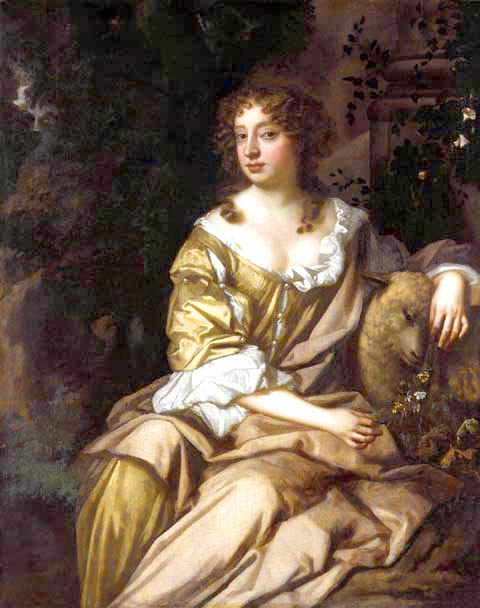
Nell Gwynn by Peter Lely c.1675
Local tradition has it that she was here either when she was
pregnant by the king, or at the time typhus was raging in London,
when Charles sent her to Tring under the protection of his finance
minister, Henry Guy, to whom he had granted the Manor of Tring.
Some accounts say she was housed in a property commonly known as
Elinors in the Lower Dunsley area. What we do know is that
the first Lord Rothschild tried very hard when he first acquired the
Tring Park Estate to establish Nell actually did live in the town
for a while, presumably to add to the historic interest of his
newly-acquired property. He employed the best researchers of
the time but they were unable to say categorically that she was.
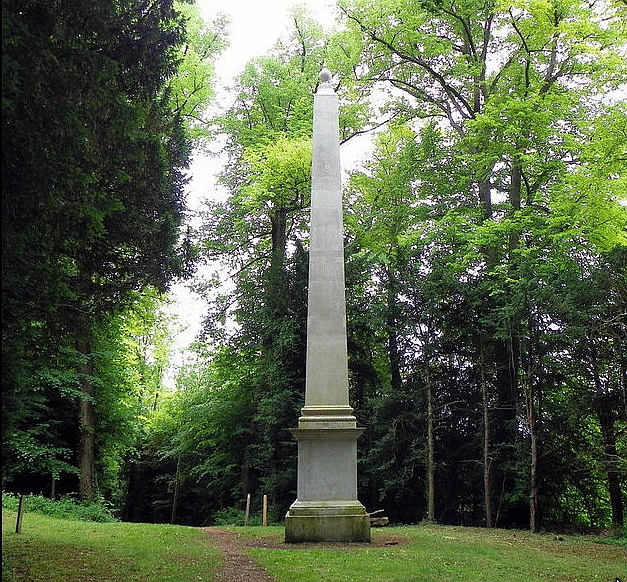
Nell Gwynn’s Monument, Tring Park
The obelisk in Tring Park known as ‘Nell Gwynn’s monument’ was
erected a hundred years or so after Nell had departed this life.
――――♦――――
THE ROAD THROUGH LOWER DUNSLEY
The original line of the approach road to Tring, from both the
easterly and westerly directions, as well as the actual route
through the town, saw many changes over the centuries.
Consequently, it is confusing and difficult to follow, especially as
some traces of the old sections of road have disappeared.
A glance at a modern-day Ordnance Survey map shows that the most
direct route from Cow Roast to Tring is the line of the age-old
livestock droving road to and from London – now the A42511 – until
the former Rothschild gatehouse, London Lodge, is reached.
At this point the original road continued straight on, entering
Tring Park and passing immediately to the south the Mansion.
On emerging from the Park it continued along Park Street and Park
Road to form a junction with Aylesbury Road at the former
Britannia public house. The road then continued along its
present route past Tring Cemetery and following a straight course to
Aylesbury.
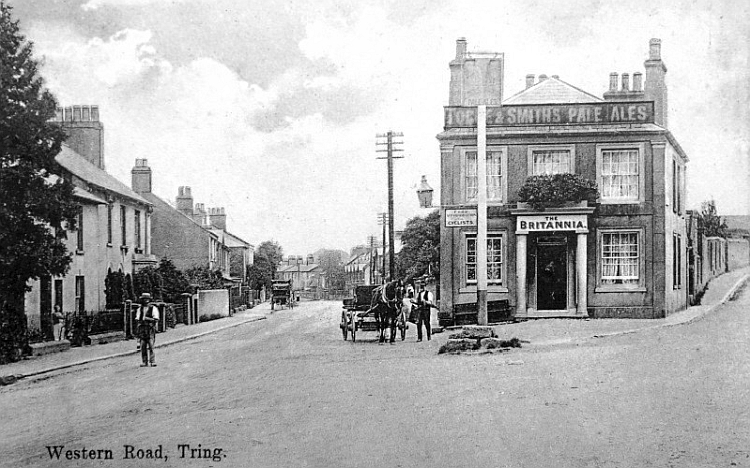
The Britannia at the junction
of Park and Western Roads
The year 1711 saw a major change to this age-old route, one that
meant greatly increased prosperity for the town until, arguably, the
end of World War II, when the tremendous growth of road transport
rendered the narrowness of the High Street inconvenient and unsafe
for large volumes of traffic.
In 1702, the Tring Park estate was acquired by Sir William Gore,
one-time Lord Mayor of London and wealthy banker. On his
death, the estate was inherited by his eldest son, William junior,
who petitioned that the main road be moved from the south to the
north side of his mansion, the story being that he disliked coaches
and wagons rumbling past his dining room windows. Given the
influence of the gentry at that time, it was probably a mere
formality that his application for the change was approved.
Tring Vestry Minutes record:
1710, 11th January. At the house of William Axtell, Rose & Crown,
Tring, an inquisition was held relating to the enclosure by William
Gore, esquire of Tring, of part of the highway from Berkhamsted to
Aylesbury known as Pestle Ditch Way [now Park Road], which
lies on the south part of his garden from Dunsley Lane to a place
called Maidenhead [an old pub]. In substitution he will
provide a road from Dunsley Lane across Tring Market Street [now
Lower High Street] and New Lane to a place in his land called
Gore Gap [now Langdon Street].
The inquisition was conducted before the Sheriff for Hertford, with
seven esquires, three gentlemen, and eight commoners forming the
jury. The verdict was, unsurprisingly, that there would be no
damage to the Queen or to others by the diversion of the highway for
a distance of 92 perches (506 yards).
This new route of the main highway as it reached Tring from the
Berkhamsted direction, still did not follow a line that would be
recognisable today. From the map below, it is possible to
discern that at London Lodge it made its way to the south of
Lower Dunsley – which was located near the site of today’s
Dunsley Place, then a hamlet in its own right – where it passed
between the houses, canvas factory and brewery to emerge opposite
the Robin Hood public house. From then on the route
corresponded with the present High Street until the ‘Gore Gap’ was
reached. Here the road turned up Langdon Street, then along
Pleasant Lane [now King Street] to join Park Road, and then down to
the Aylesbury Road.
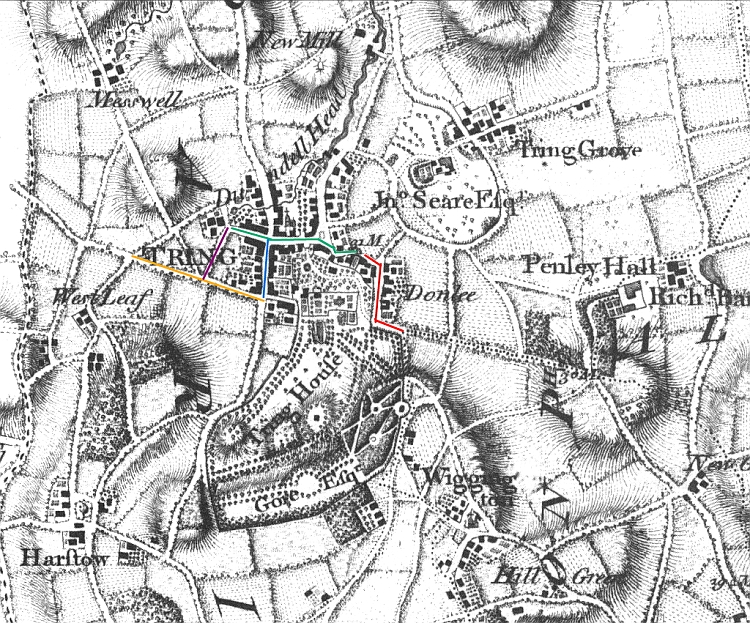
Andrews and Dury’s map of Tring,
1766 (Dunsley is spelled ‘Donlee’).
Shown in Red, the main
road through Dunsley; Green,
Tring High St; Blue,
Akeman St.;
Purple, Langdon St. (the
Gore Gap); Orange, Park
Rd.
At some time during the early-1820s, at the instigation of the
Sparrows Herne turnpike trust, [6] a new section
of road was also built between London Lodge and Lower Dunsley, the
work being undertaken by James Bull of Tring. [7]
This necessitated some road widening, the demolition of dwellings
and payment of compensation. William Kay, then Lord of the
Manor, was awarded £248.15.0d. compensation compared with the £4
17s.0d. to the four cottagers who were obliged to quit their homes.

From an OS map of 1879, showing the new route of the
main road highlighted in red, and the
truncated remains of the former road through Dunsley
in blue.
From the following entries in Tring Vestry Minutes and the Bucks
Herald it seems that the remaining section of old road through
Dunsley hamlet was not closed finally until 1883, a date that
roughly corresponds to that when Lord Rothschild decided to
incorporate the whole area into his private gardens.
“1883. The old road at a point on the south side of the High
Street, adjoining the Manor Brewery, and the Canvas Factory, is to
be closed. This refers to Lower Dunsley.
“1883, 25th August – Notice has been issued
notifying the intended closing in the usual way of the now useless
road at the southern end of Tring . . . . “
Eventually all the buildings in the hamlet of Lower Dunsley were
demolished, and those displaced by the stopping up of the old road
and the landscaping of his lordship’s new gardens were found
replacement housing. (It is likely that the cottagers affected by
these changes were found improved accommodation, for it was always
Rothschild’s policy to treat tenants or, in fact, any townsfolk
unfairly.)
――――♦――――
INDUSTRY IN LOWER DUNSLEY
–
CANVAS WEAVING
Canvas, a durable plain-woven cloth, was traditionally made from
hemp (cannabis sativa) an undemanding plant with a long
fibrous stem and six times as strong as cotton. The fibres,
from 3ft. to 15ft. in length, commonly called bast, grow on
the outside of the woody interior of the plant’s stalk, and under
the outermost part of the bark.
There does not appear to be a tradition of hemp growing in the Tring
area, [8] and no one can say exactly why
canvas weaving started as a small industry in various locations in
the town. Writing in the 1890s, Tring local historian Arthur
Macdonald states that:
“The canvas industry is said to have been introduced [to
Tring] by a colony of Flemings who settled here. Some of their
names remain, as Delderfield or Delderfeldt (‘Darofel’), and Wilkins
(‘Wilquin’)”.
Those Calvanists who migrated to England from the Continent to
escape persecution on account of their faith brought with them many
craft skills. They were often master weavers or journeymen
specializing in various branches of the textile industry, mainly
silk, although some Huguenots practiced the craft of canvas
sail-making in England long before then. However, no firm
records have been discovered of their descendants arriving in Tring.
The first documented evidence of canvas weaving in Tring comes from
entries in the Militia Lists from the middle to the end of the 18th
century, which record men working as rope-makers, as well as one
flax man and one hemp dresser. Pigot’s trade
directories from 1825 to 1839 list four proprietors of weaving
shops, and Arthur Macdonald describes the first of these as follows:
“Entering the town from the east, the first building on the left
is the pretty pair of cottages [Lower Dunsley Cottages] built
by Lord Rothschild on the site of an old canvas weaving shop, then
owned and occupied by Mr John Burgess, and before him by Daniel and
Harding Olney. The Olneys were a family of some position in
the town, being the principal canvas manufacturers and possessing
several properties. William Olney had weaving shops in Akeman
St., which he converted into the Akeman Brewery.”
By ‘some position in the town’ Arthur Macdonald presumably refers to
the Olney family’s high standing at the New Mill Baptist chapel, at
a time when Non-Conformity was at its height. Daniel Olney
senior was Deacon at that church, and his brother, Thomas, also had
a high profile in the Baptist movement.
John Burgess, advertising his trade as “canvas manufacturer of
open canvas for ladies needlework, gunpowder canvas, cheese cloths
etc.” carried on weaving in the premises at Dunsley until it was
shut down in 1883. It was demolished two years later, along
with other nearby properties, to make way for the erection of the
attractive Lower Dunsley Cottages (now Grade II Listed) opposite the
Robin Hood pub.
An account in the Bucks Herald of 26th December 1885 states:
“At Dunsley, where formerly was a lot of houses and a canvas
manufactory, with the residence of Mr Burgess, a great change has
been effected by Lord Rothschild.
The whole valley has been filled up with earth brought from Albert
Street and Western Road, where the foundation of a new General
Baptist Chapel is being dug. Instead of the familiar factory
before-mentioned, a handsome and substantial house [sic]
meets the eye, on the top being an exalted vane and six or eight
twisted chimneys in which Norris’s ornamental bricks are used.
This improvement has afforded employment to a large number of
people.”
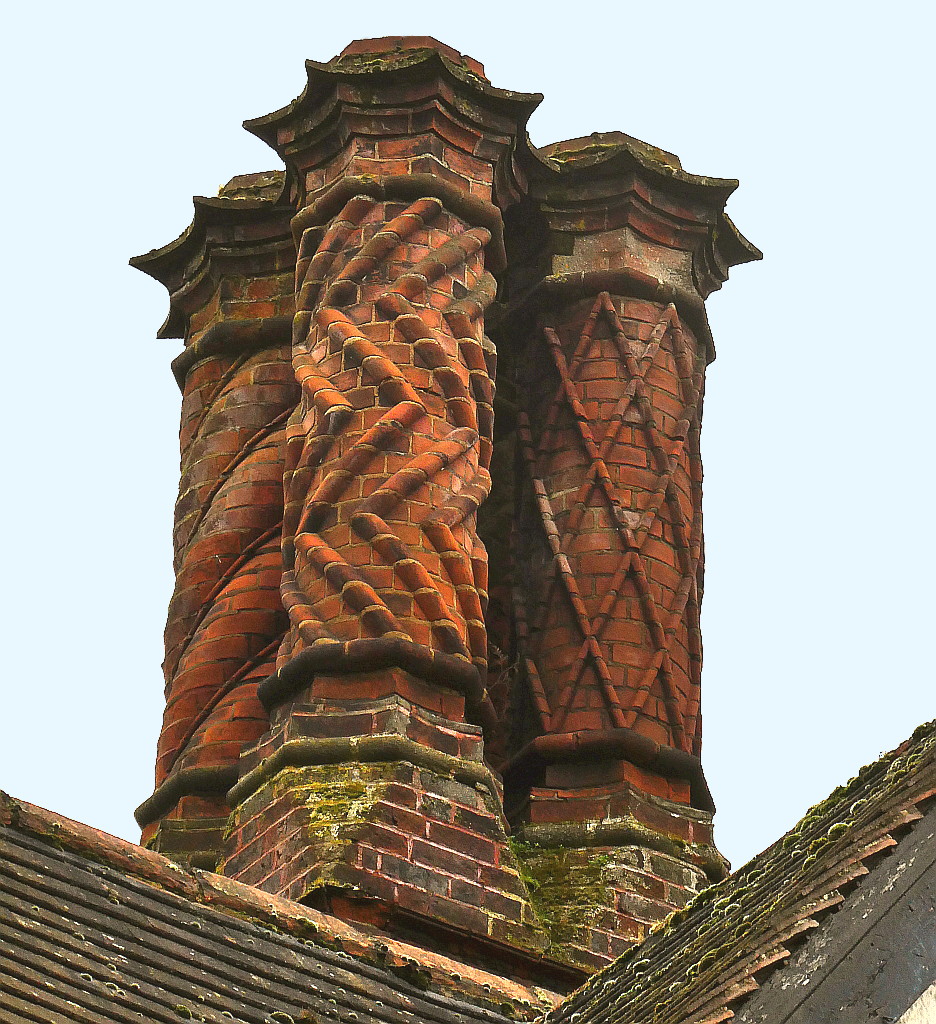
Four of the eight ‘twisted
chimneys’ atop Dunsley Cottages.
As far as can be ascertained, the development above always comprised
two separate cottages, so in his description the Bucks Herald’s
reporter was in error. In any case, it appears that during the
1880s substantial changes were being made to the general townscape
of Tring, many of which remain and are familiar to us today.
――――♦――――
INDUSTRY IN LOWER DUNSLEY
–
THE MANOR BREWERY
At sometime before the mid-1800s, Seabrook Liddington leased land
from the Tring Park Estate on which he built the Manor Brewery and a
maltings sited in New Mill. The premises consisted of the
brewery with a side entrance to an off-licence known as ‘The Hole in
the Wall’ (said to be older than the brewery). When Seabrook
retired he built a new house at New Mill and continued his business
of malting. A highly respected member of the community,
Seabrook became Tring’s oldest inhabitant, dying at the age of 94,
having been born in Tring in 1808.
James Liddington, a distant relative and former landlord of The
Victoria public house in Frogmore Street, took over the Manor
Brewery. He was succeeded by Mrs. Rebecca Liddington.
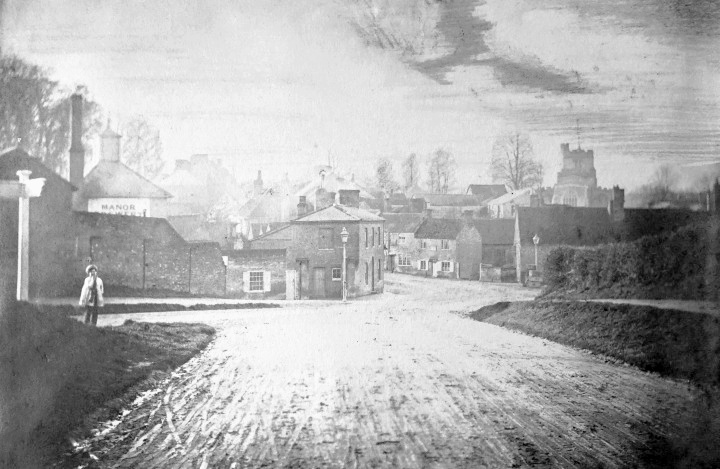
The
approach to Tring from Station Road, c.before 1896 –
The Manor
Brewery with chimney is dimly discernible on the left
In the Tring Park Estate auction sale particulars of 1872, the
brewery was offered for sale freehold and comprised:
“a substantial brick building of three storeys, with a
brick-built and slated four-bedroomed house, two parlours, two-stall
stable, several piggeries, wash-house, office, and two adjoining
cottages”.
The rental was £48 per annum. When the Manor Brewery fell into
disuse it, together with other premises in the Lower High Street
including The Green Man public house, was finally demolished
in 1896, and the high curved wall we know today was erected around
what is now the area of the Memorial Garden.
――――♦――――
TRING PARK GARDENS –
THE ROTHSCHILDS
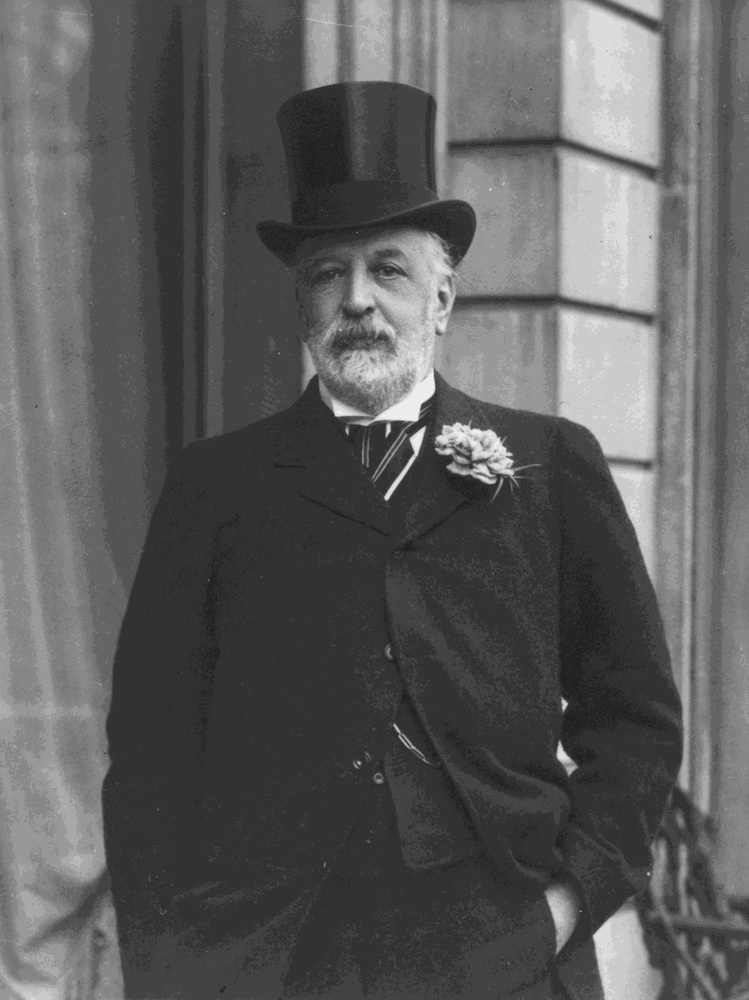
Nathaniel Mayer Rothschild,
1st Baron Rothschild (1840-1915)
Unlike many of his relatives, the first Lord Rothschild [9] was not a
passionate gardener, and practical matters relating to farming and
agriculture held far more appeal for him.
However, in the 1880s when Tring Park mansion was remodelled,
substantial alterations to the gardens were also undertaken.
As the new landscape design matured, Nathaniel Rothschild did become
interested and he became knowledgeable about the names and qualities
of shrubs. His wife is known not to have favoured too much
formal planting and at the south front of the house, except for a
few flowerbeds (sometimes displaying the Rothschild racing colours
of blue and gold), the landscaping remained soft. The lawn was
extended and a new ha-ha constructed to allow an uninterrupted view
to the wooded escarpment on the far side of the park.
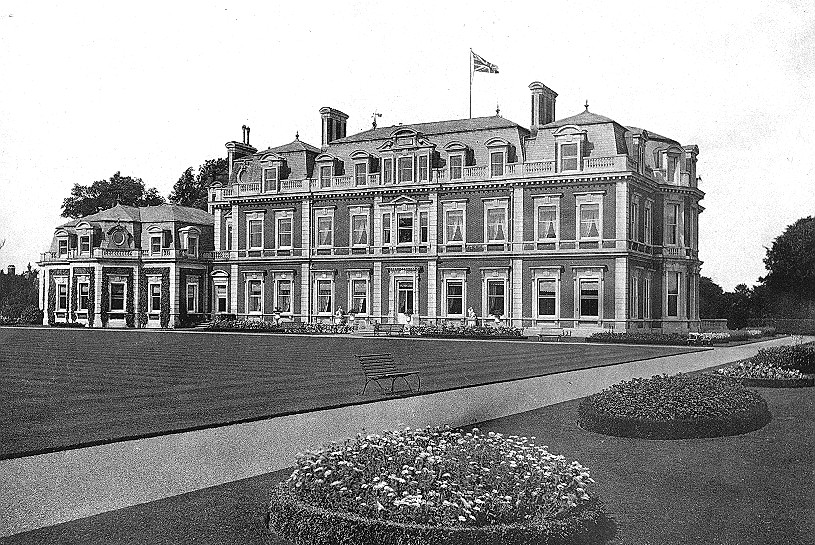
Tring Park Mansion following
the Rothschild alterations
The area known as ‘the pleasure gardens’ to the west and north of
the house was extensively remodelled and replanted. A
description written at the time records that they featured a summer
house and an Italian garden and fountain. A sunken path, lined
with flint, led to an under-pass which still survives. This
ran beneath the drive leading to the stables, and gave access to a
winter tennis court; a topiary garden clipped into the shapes of
tables, chairs, and chess pieces; a Dutch garden; an Elizabethan
garden; and a number of other areas.
An account in the gardening press at the time says:
“Each of these little gardens is complete in itself; once
entered, the whole comes under the eye in an instant, but nothing is
seen of the gardens beyond, for each of these separate designs is
encircled by an irregular bank, planted with rare Conifers and
shrubs, faced with flowering plants, Lilies, and Roses, and in all
cases with as many annual or perennial sweet-scented plants as
possible”.
The account reads on to wax lyrical about all the chosen bedding,
including purple Clematis, Begonias, Violas mixed with silver
Pelargoniums, Cannas, Marguerites, white Nicotiana, and Sweet-peas.
That same year, a correspondent from The Gardeners’ Chronicle
visited Tring Park, and in his article he comments with
surprise on the modest entrance and approach to the estate.
But once beyond the stables area, matters obviously lived up to his
expectation of a home appropriate for the richest man in the British
Empire. The following extracts give a good description of the
gardens at that date:
“A broad new carriage drive leads to where a grand entrance to
the house is evidently meditated, and on the right of this approach
is a bank of evergreens. It was planted only eighteen months
since with large shrubs of Yew, Bay, Box, and Aucuba japonica
. . . . Passing round the house you will find a lawn, much
enlarged recently, and clipped about by a very unlevel park,
beautifully planted with clumps of Limes, animated by deer and
shorthorns, and enclosed by masses of encircling Beech woods on the
high ground which bounds the view.
. . . . Among the proofs of outlay, as well as of excellent
taste, are the numerous costly shrubs around the house, including
the bushes of Golden Yews grown from cuttings, as well as the much
rarer seedlings. I dare say thousands have been expended in
shrubs lately . . . . Numbers give only a mechanical idea of works of
planting like those which Mr Hill (the head gardener) with his men
and long hose has brought to such a successful issue; but it may
please nurserymen, and make their mouths water, to repeat that 500
Golden Yews, costing a great sum, have been planted here, and 10,000
bulbs of Gladioli set in the shrubberies to enliven them. . . . . I can only say that it (the garden) is filled with costly “things”,
and in standing before the largest Japanese specimen, which is many
times repeated in smaller sizes, one cannot help counting the cost.
It is the beautiful Retinospora obtusa nana aurea and is
worth seven guineas. The double Spanish Gorse is used as an
edging of this grand clump of shrubs, and I observed several
specimens of weeping Yew on stems one foot or more high, and then
spreading horizontally. . . .
The kitchen gardens are on the roadside near the town, and will soon
be entirely shut in by walls, and enlarged from three to six acres.
The glasshouses are numerous, and the management unsurpassed.
Five houses are devoted to Orchids, and two entirely to Carnations,
one of them to the favourite Malmaison. The foliage
plants, Crotons, Caladiums, Alocasias, Dracænas and others were
superb, and the varieties of Begonia and Coleus looked charmingly
bright. I believe that a London firm decorates the London
house so far as pot plants are concerned; but the cut flowers are
sent from Tring, and two houses of Adiantum ceneatum are
required for the growth of Fern foliage by the bushel.
There are five vineries where the Muscat of Alexandria Grapes, of
five years’ growth, are as good as can be, and the adjoining Black
Hamburgs too having this year the largest berries yet produced here.
In the Fig-house the first crop was just over, and the second coming
in. . . . The Orchard-house is simple and comparatively
inexpensive. It consists of 135 yards of wall, enclosed by
glass, having hot-water pipes to keep the temperature above
freezing, and making all the wall fruit – Apricots, Peaches, Pears,
and Plums – perfectly secure.”
The article goes on at great length in the same vein, and also makes
mention of ‘the cottage’, the home of the unmarried gardeners.
This was replaced in 1905 by The Bothy, a fine new building
where the boys were well-cared for by a housekeeper. (The Bothy
later became the premises of Williaam [sic] Cox, a firm
manufacturing plastic sheeting, until finally demolished in the
1990s to make way for Tesco’s supermarket.)
Death duties and the effect of two devastating world wars had taken
their toll, and by the time of Lord Rothschild’s grandson, matters
had begun to change. A description written by Bob Poland,
recently appointed as Greenhouse Foreman at Tring Park, gives
some idea of how things were.
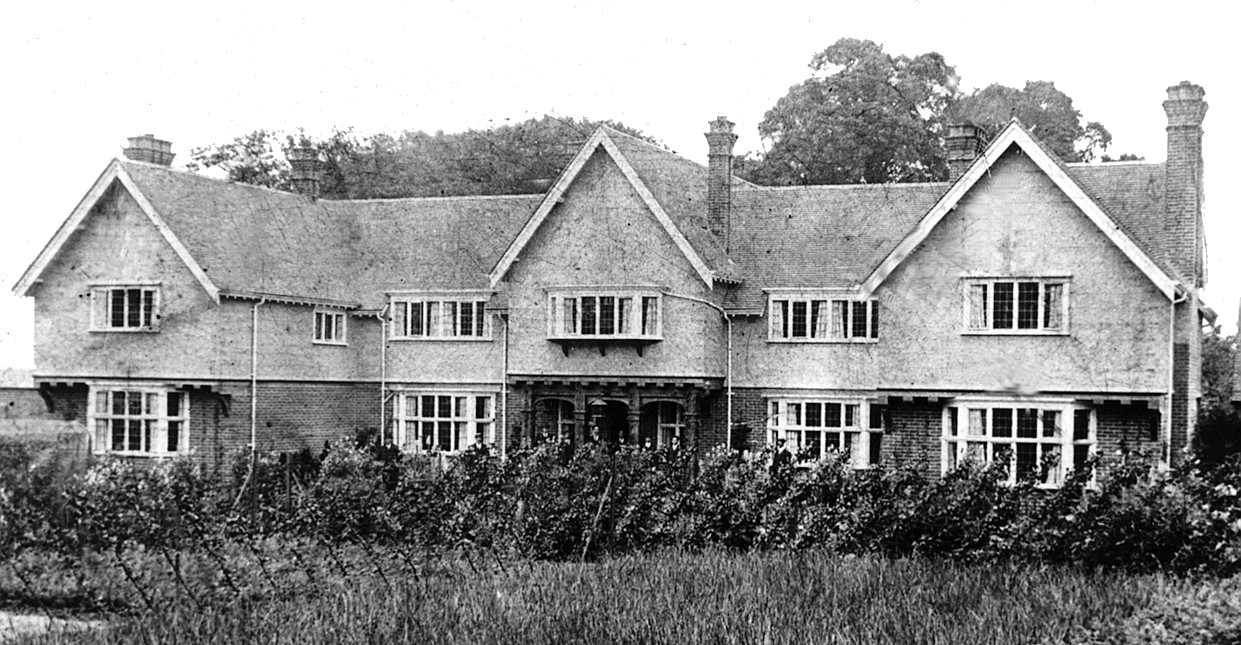
The Bothy c.1910, now the site
of a Tesco supermarket
Arriving at his new job one Saturday evening in November 1934, he
was stunned when the head gardener called for him at The Bothy
at
9 a.m. the next morning. He was instructed to start cutting
fresh flowers ready to be sent to the Rothschild houses in London
and Cambridge. On enquiring when they were wanted, he was told
to leave them in water overnight, but to be up at 3 a.m. the
following day “as the van calls at 6.20 a.m.” and only two
men would be available to help.
Bob Poland’s new empire was larger than anything he had experienced
before, and he describes the glasshouses with 18 miles of piping and
boilers consuming 30 tons of coke each week, all shovelled by hand.
These glasshouses were not as they had been in their heyday, and Bob
recounts they “were in an awful state with every known greenhouse
pest - thrips, mealy bug, red spider, and millions of ants”.
In an attempt to rid the gardens of pests, he persuaded the head
gardener to pay the men so much each for the tails of rats, mice,
moles, and for Queen wasps.
Once the major problems had been dealt with, Bob came to enjoy his
job for his duties were varied. When the family was in
residence, his responsibilities included supplying and arranging all
the floral decorations in the house. Busying himself in the
flower room on the ground floor of the mansion, Bob provided the
sumptuous arrangements that were changed twice a week, and those in
the dining room once a day, or sometimes twice. At the festive
season a huge 30 ft. Christmas tree stood in the centre of the
staircase well, and hundreds of flowering pot plants were used to
decorate wherever space permitted.
Not much time or effort could be spared for gardening during WWII
and the grounds of Tring Park became neglected and overgrown.
During the conflict the staff from the Rothschild bank in the City
of London moved into the house, and the stables were used by the
Home Guard, the ARP, and the Red Cross. Shortly before the
war, the 3rd Lord Rothschild had offered Tring Park house, grounds,
park, and woodlands as a gift to the British Museum of Natural
History. The committee appointed to consider this did not
accept it. The mansion then became the Arts Educational
School; part of the ‘pleasure gardens’ was later dedicated as the
Memorial Garden; The Bothy was used to house engineering
staff from the Royal Mint Refinery in Brook Street; and later the
route of the A41 by-pass sliced through the park. Like many
similar estates all over the country, the golden days were over and
nothing was ever the same again.
The remaining areas of the kitchen gardens fronting the main road
were developed as two separate closes of modern houses, the one
nearest the town named Dunsley Place, the original high walls having
been preserved are now listed. A back gate from Dunsley Place
leads through the Memorial Garden making a pleasant short-cut into
the centre of the town.
――――♦――――
DUNSLEY FARM
When the Rothschilds acquired the Tring Park Estate at auction in
1872, it included Dunsley Farm. At an auction of the Estate in
1820, the farm then comprised 240 acres (part in Wigginton Parish).
Held by various tenants since, the present farmhouse building was
erected in 1881, at a cost of £300.

Plaque
on Dunsley farmhouse depicting a section of the Rothschild
coat-of-arms
and motto
– Industria, Integritas, Concordia
In 1919 the Hon. Charles Rothschild of Tring Park,
anxious to help returning servicemen to settle on the land, sold 180
acres of Dunsley Farm to Herts County Council for use under the
Government ‘Homes for Heroes’ scheme. This included a 2-acre
area of farmland in Cow Lane for lease as a small farm, and also an
orchard where a wooden bungalow was erected. Later, further
acreage belonging to the farm was sold, providing 10 building plots
in Station Road and Cow Lane. Nowadays, the area immediately
around the farmhouse includes a farm shop, a café, the operating
premises of Tring Brewery, and a duck pond.
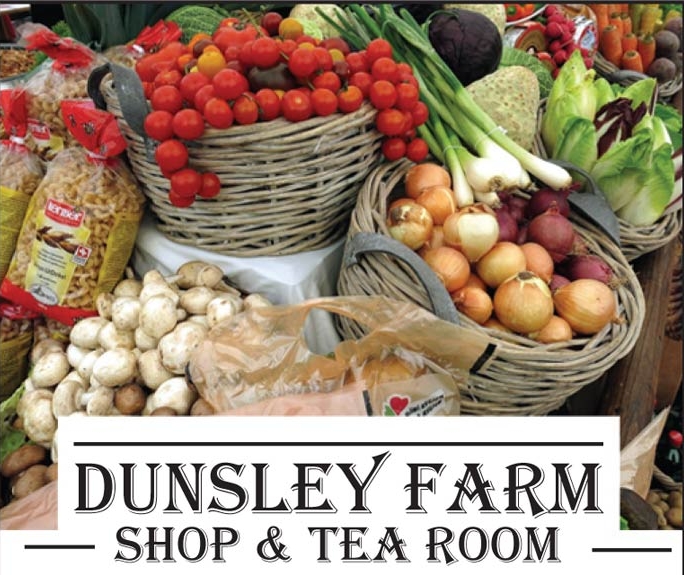
――――♦――――
TRING PARK - HEAD
GARDENERS
For many years the Garden House, a pretty Regency house with
Gothic-style windows, was the home of successive head gardeners on
the Tring Park estate. It enjoyed an open aspect and
was not shielded from the London Road until much later, when high
brick walls were built to enclose the entire kitchen garden.
During the early Victorian period the various occupants included
William Brown, William Ivory, and James Smith, who also ran a seed
merchant’s shop in the High Street. The privilege of living in
the Garden House did not come easily as, on any large country
estate, the head gardener was a figure of immense importance, whose
knowledge of gardening matters, control of men, and organisational
skills were expected to be all-embracing. But in 1877 this did
not prevent the Rothschild family appointing to the post a youthful
27-year old Gloucestershire man, Edwin Hill.
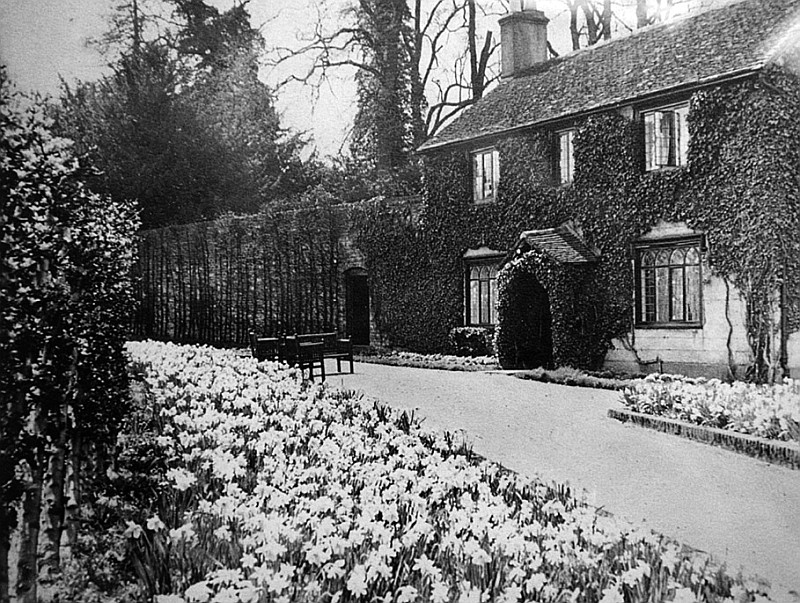
The garden House, Dunsley,
c.1910
For the next 27 years Edwin re-organised and maintained the grounds
around the Mansion. As his experience grew, he became a
well-respected member of his profession and was recognised as such
by being elected to the committee of the Royal Horticultural
Society. He also laid out the gardens of the newly-built
Louisa Cottages in Park Road, and those of the Isolation
Hospital on the road to Little Tring. He acted as Secretary of
the Cottage Garden Society, an organisation close to Lady
Rothschild’s heart, and was expected to arrange the athletic sports
on show day. Edwin died at the early age of 54 and his
obituary appeared in the Gardeners’ Chronicle.
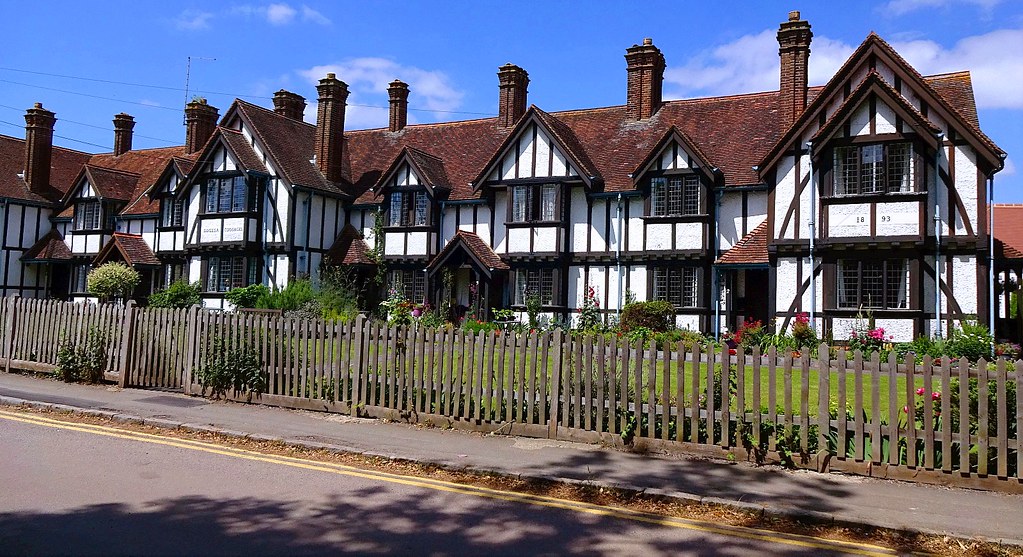
Louisa Cottages
Edwin was succeeded by his assistant of eight years, Arthur Dye, who
came to Tring Park with the very best credentials. Born
in Norfolk, he started his career in the Royal Gardens at
Sandringham, later moving to the Royal Lodge at Windsor.
When he arrived to take up his position at Tring, Arthur and his
wife were tenants in one of the Louisa Cottages, but
following Edwin Hill’s untimely death they moved to the Garden
House within the walls of the kitchen garden. Living in
this splendid house had, at times, certain disadvantages. On
spring nights when the apple-blossom was in flower, a bell sometimes
sounded a warning that the outside temperature had fallen below
freezing point: Arthur then had to leave his warm bed to ensure that
fires were lit in the orchards. (Propped up in his bedroom was
a shotgun, which he used to dispatch any unwelcome Glis Glis who
trespassed into the loft space.)
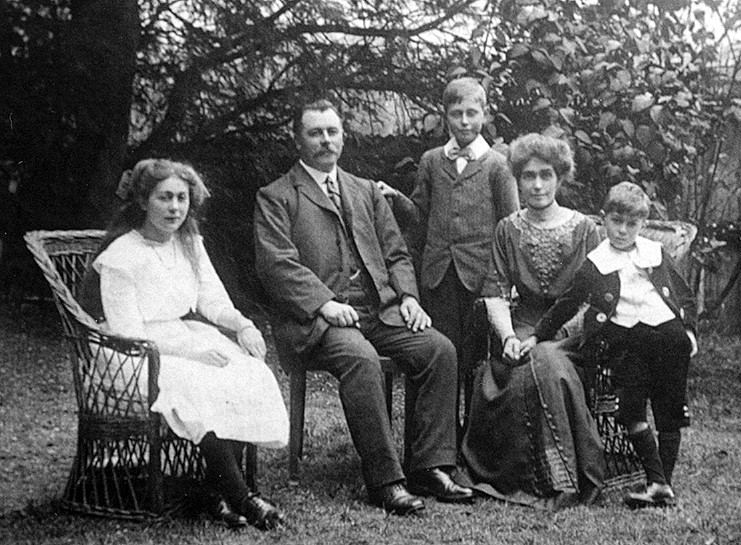
Arthur Dye and family in the
garden of the Garden House
His new responsibilities included the welfare of the unmarried
gardeners living at The Bothy. Liaison with other
senior staff members such as the chef and butler were also part of
the job. One very special task each year was a visit to
Buckingham Palace, bearing Lord Rothschild’s gift of flowers to
decorate Queen Mary’s breakfast table. Arthur remained head
gardener for forty years, and on his retirement moved to a
Rothschild property, Woodlands, in Chesham Road, Wigginton.
There he enjoyed 25 years tending his own large garden where he
waged a constant war against Wigginton’s rabbit population.
In the summer months it was the practice for owners of large houses
to open their gardens to the less privileged local folk of the
district. These events were greeted with mixed feelings by
head gardeners. Their natural pride and pleasure in
compliments were weighed against possible hazards to their precious
plants. At Tring Park during the annual Agricultural
and Flower Shows, ‘Freedom of the Park Day’ meant all could wander
around the grounds and gardens, but some very necessary preparatory
work had to be done. The park was home to a variety of exotic
creatures belonging to Walter, eccentric zoologist son of Lord
Rothschild. Throughout the year kangaroos, emus, and other
animals roamed freely, but of course had to be kept under control on
the great day. Beforehand, an army of gardeners’ boys were
deployed to clean up the park, in a thoughtful attempt to preserve
the Sunday-best boots and shoes of the visitors.
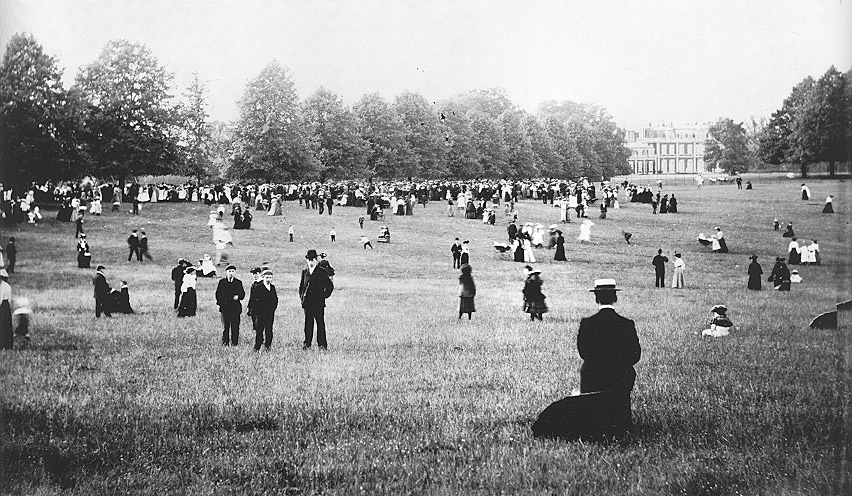
‘Freedom of the Park Day,
c.1910’
――――♦――――
TRING MEMORIAL GARDEN
(on the site of Lower Dunsley)
|
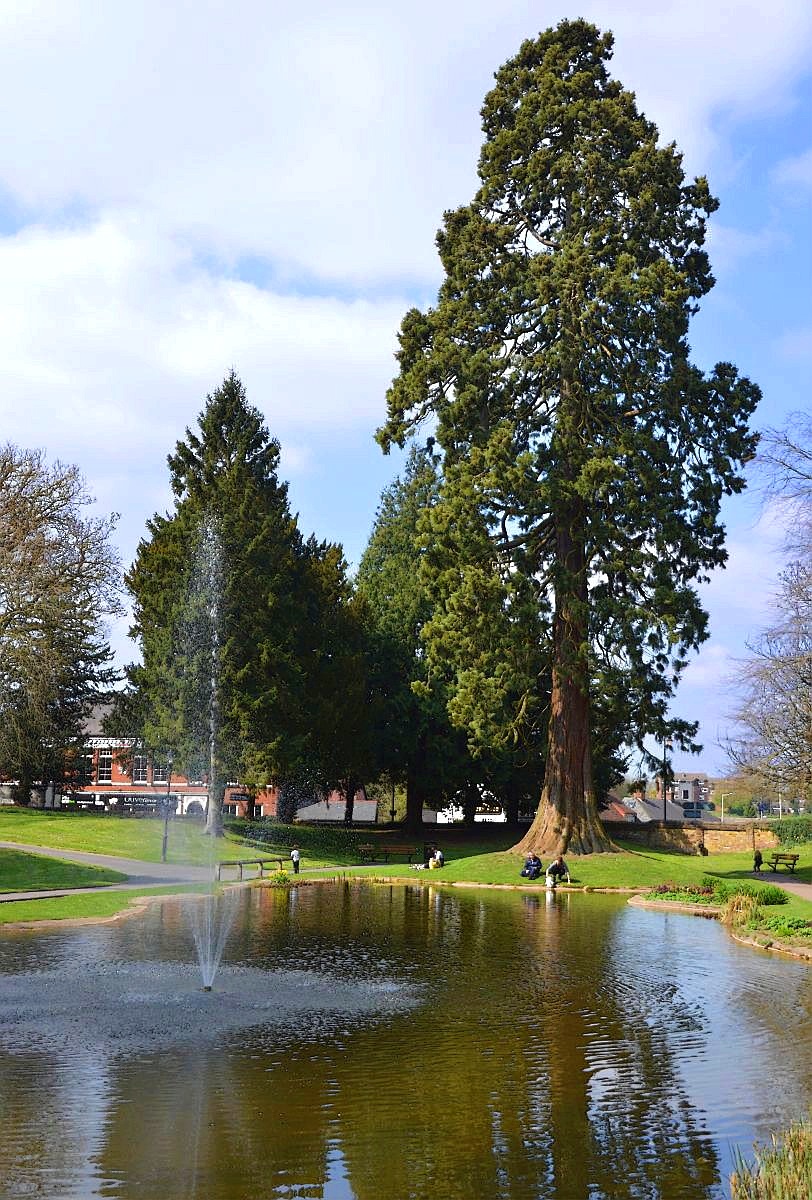 |
|
Tring Memorial Garden |
The area covered by the present garden had been created in the
1890s when several properties in the Lower High Street were
demolished. These included Rose Cottage, once the
home of a Tring solicitor, and the Green Man, an
early-Victorian public house erected by the proprietor of Tring
Brewery. A large irregular-shaped lake was dug out and planted
with different species of water-lily, and the whole surrounded by
abundant picturesque planting. The entire garden was hidden
from view from the main road by a high brick wall and a thick screen
of trees and shrubs.
In March 1947 a questionnaire was
circulated in the town to canvass opinion about how best to honour
Tring’s war dead. The outcome was 107 votes for a sports
centre, 67 for improvements to the Victoria Hall, and 180 for a
public garden with a paddling pool. Possibly the absence of a
definite project led to a disappointing and rather shameful response
to the accompanying appeal for funds. The Council decided that
the paltry sum collected of £20 6s.2d. could only finance the
addition of names of the fallen to be added to the existing
memorial in front of the parish church.
Disquiet over
this outcome led Tring to wake up, and three months later a public
meeting was held and a committee of twelve members elected to launch
a firm appeal with the target of raising £5,000. The stated
objective of the scheme was to provide a fitting memorial (other
than a monument) to those who had fallen in World War II, as well as
a thanksgiving for those who had returned home safely.
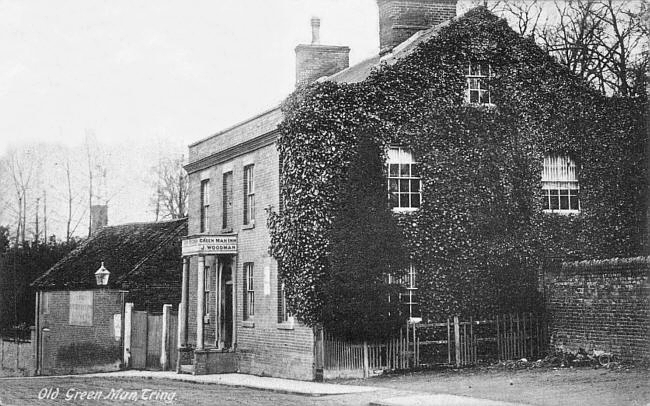
The Green Man
Considerable interest was taken in this new appeal fund, and a
well-known Tring shopkeeper came up with a novel idea to start the
ball rolling. He suggested that businessmen should give £1 for
every year they had been trading in the town. On this basis,
his own welcome contribution amounted to £25, and others soon
followed his example. The committee again invited suggestions
as to the form the memorial should take. Among the ideas put
forward was a swimming pool, but the Council considered the running
costs would be too great.
Eventually, and after much debate, it was decided to create a
Garden of Remembrance in the old water garden of the Tring Park
estate. In the years after World War II the lake and its
surroundings presented a sorry sight. For years, the area had
suffered almost total neglect and had become overgrown, dark, and
depressing. Any idea that the water garden could revert to its
former glory was clearly impossible, as it was realised that the
number of gardeners required for its maintenance would never again
be available in the modern world. Instead it was thought that
clearance of the area, resurfacing the lake bed, and some simple
replanting would offer an acceptable and pleasing aspect as a public
open space.
Even so, nothing happened quickly. Three
years passed before the legal process of transferring the site to
Council ownership was settled, and thereafter work proceeded slowly.
It was another three years - in June 1953 - before the garden was
formally opened, an event planned to coincide with the Coronation of
Elizabeth II. Over 200 people were present at the unveiling
ceremony, the dedication service being conducted by the Reverend
Lowdell, Vicar of Tring.
The garden was enjoyed for some
years before it fell victim to mindless vandalism, but when Mrs
Westron, widow of Tring nurseryman Frank Westron, died in 1971 she
bequeathed £50 to be spent on the Memorial Garden. The Council
then decided to use this sum towards repairing the damage.
Today the lake (fed by natural springs rising in Tring Park)
looks very different from how it was in the time of the Rothschilds.
All the vegetation surrounding the perimeter has been cleared,
allowing an uninterrupted view of the magnificent Wellingtonia
that towers over the northern end. In recent years some
alterations have taken place, following criticism that the approach
to the gardens was dark and uninviting.
The Council then
organised contractors to thin trees and shrubs bordering the
entrance pathway, allowing more daylight to provide a welcoming
aspect. In 2001 the lake had to be drained and the fish
evacuated when it was necessary to investigate the cause of serious
water seepage. A bad crack in the concrete base was
discovered, repaired, and four carp returned to the water following
their sojourn at a nearby fish farm.
Members of the Tring branch of the British Legion attended
a reopening ceremony, and presented a plaque listing the names of
those men from the town killed in World War II. This is
mounted on the brick gate-pillar at the entrance. Later, in
2018 in a ceremony to commemorate the end of WWI, a second plaque
was mounted on the other side of the gate to remember all those from
the town who served in that conflict.
It is pleasing to record that Tring’s Memorial Garden is well
used every day of the week and in most weathers, thus repaying the
work of volunteers (Friends of Tring Memorial Garden) as well as the
maintenance and planting services provided by Dacorum Council.
Folk of all ages enjoy this space, whether just sitting on a seat in
the sunshine or, in the case of children, dashing round the
footpaths on scooters. Dog walkers are also in evidence, and
most are considerate in clearing up the inevitable mess. In
recent years, small notice boards have been sited at intervals
around the lake offering brief explanations of various aspects of
the two wars, or commemorating individuals who fell.
――――♦――――
NOTES
1. THE MANOR OF TRING:
Matilda, daughter of Count
Eustace of Boulogne, inherited the manor from her father. She
later married Stephen of Blois, a grandson of William the Conqueror
who later became King Stephen of England. In 1148 King Stephen
and Queen Matilda founded the Cluniac order of St Saviour at
Faversham in Kent, and they presented the Manor of Tring to the
abbey. It was later exchanged for other properties with the
Archbishop of Canterbury. When Henry VIII dissolved the
monasteries during the 1530s, the manor was confiscated and became
Crown property remaining in Royal hands until the reign of Charles
I. In 1650 Charles I arranged to have the manor transferred to
his wife, Queen Henrietta Maria, only for it to be confiscated by
Parliamentary Forces during the English Civil War. In 1660 the
manor returned to royal ownership under Charles II who, in 1680,
gave it to his finance minister Sir Henry Guy. It is believed
that Guy used his position to subsidise the construction of a new
manor house – but not that existing today – to a design by Sir
Christopher Wren.
2. Domesday valuations present a problem - exactly what
value were they? Do they represent the manor’s capital value
(what it might fetch at sale)? Or are they annual rents paid
to the lord by his tenants? Or are they the total income
including the sale of produce of the lord from his manor? Or
are they the tax levied on the lord of the manor? It seems
most likely that they were annual payments, probably the annual
rents paid to the lord by his tenants.
3. Tring once possessed four hamlets: Little Tring
(the location of the Grand Union Canal pumping station); Dunsley,
which bordered the Tring Park Estate; Hastoe, to the south; and
Tring Grove, to the east. Little Tring and Hastoe survive as
satellites of the town, while Dunsley and Tring Grove have been
absorbed into it.
4. Hide – a land-holding that was
considered sufficient to support a family.
5. In referring to the hamlet of Dunsley, Volume 2
of A History of the County of Hertford (1908) states that “The
manor house has quite gone, and was replaced by a farmhouse about
thirty years ago.” The farmhouse referred to was built in
1881.
6. The
Sparrows Herne Turnpike Road from London to Aylesbury was an
18th-century English toll road. Its route was approximately that of
the Edgware Road, then through Watford, Kings Langley, Apsley, the
Boxmoor area of Hemel Hempstead, Berkhamsted and Tring to Aylesbury,
much of which is now covered by the A4251. North of Aylesbury
it linked in with other turnpikes forming a route to Birmingham.
7. In his notes on the Town’s history, former
local historian Arthur MacDonald left a brief mention of James Bull.
Besides building the turnpike bypass around Dunsley, Bull
superintended other of the Town’s road construction projects:
“Bank Alley [off Tring High Street] . . . . was formerly
the emporium of Mr Bull, saddler, a leading man in the place and
very wise in road making. He superintended the formation of
the cutting embankment at Beggar Bush Hill [now Tring Hill]
on the Aylesbury Road, also the making of the new Station Road in
1838, when he and Mr William Brown were Highway Surveyors. He
held the post of Parish Constable at the same time, with great
effect upon unruly railway navvies.”
8. At New Ground on the A4251, a ‘Hemp Lane’
connects the main road to Wigginton village.
9. Nathaniel Mayer Rothschild, 1st Baron
Rothschild, Baron de Rothschild, GCVO, PC (8th November 1840–31st
March 1915) was a British Jewish banker and politician from the
wealthy international Rothschild family. Rothschild worked as
a partner in the London branch of the family bank, N M Rothschild &
Sons, and became head of the bank after his father's death in 1879.
During his tenure, he also maintained its pre-eminent position in
private venture finance and in issuing loans to the governments of
the US, Russia and Austria.
――――♦―――― |